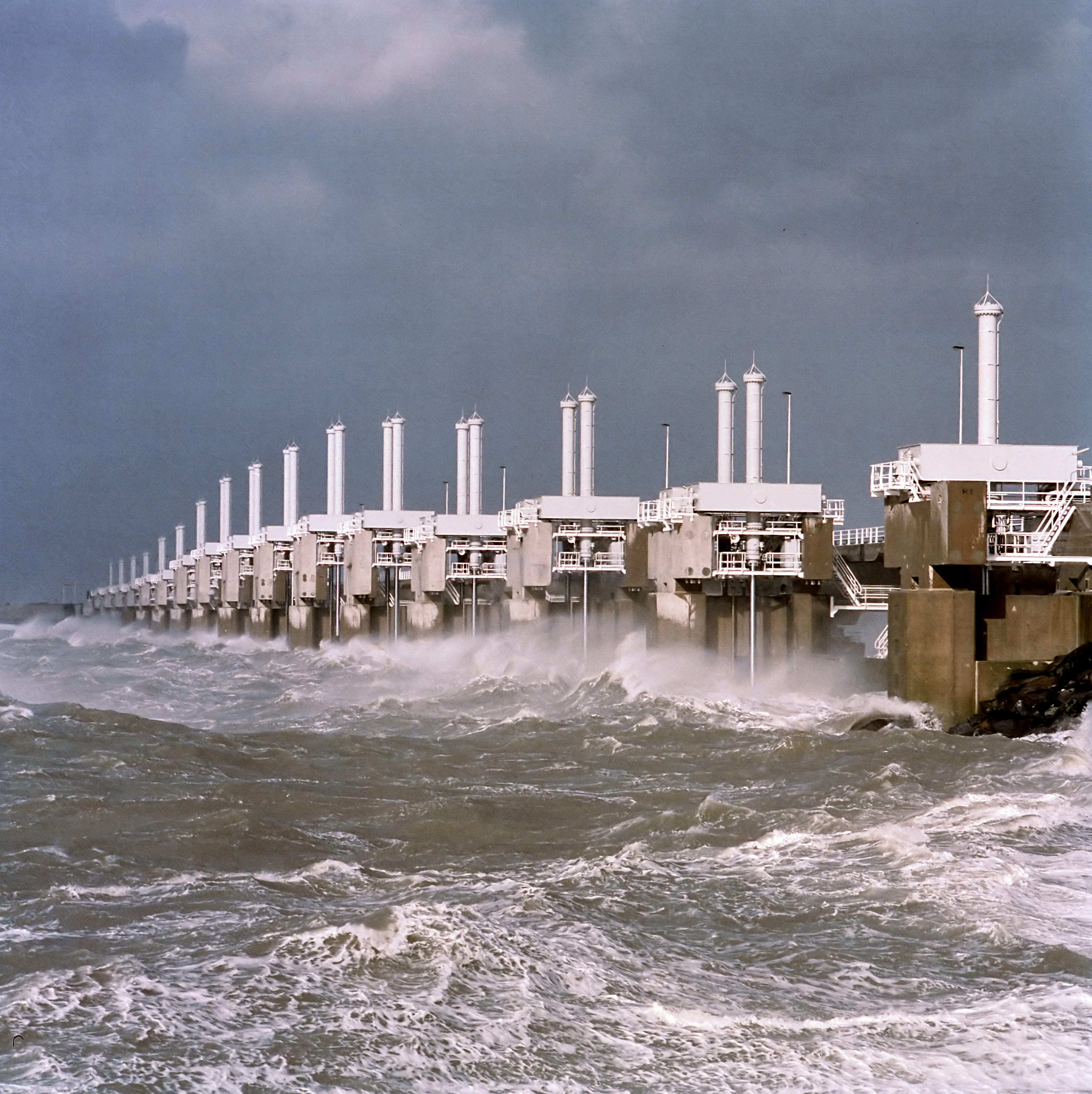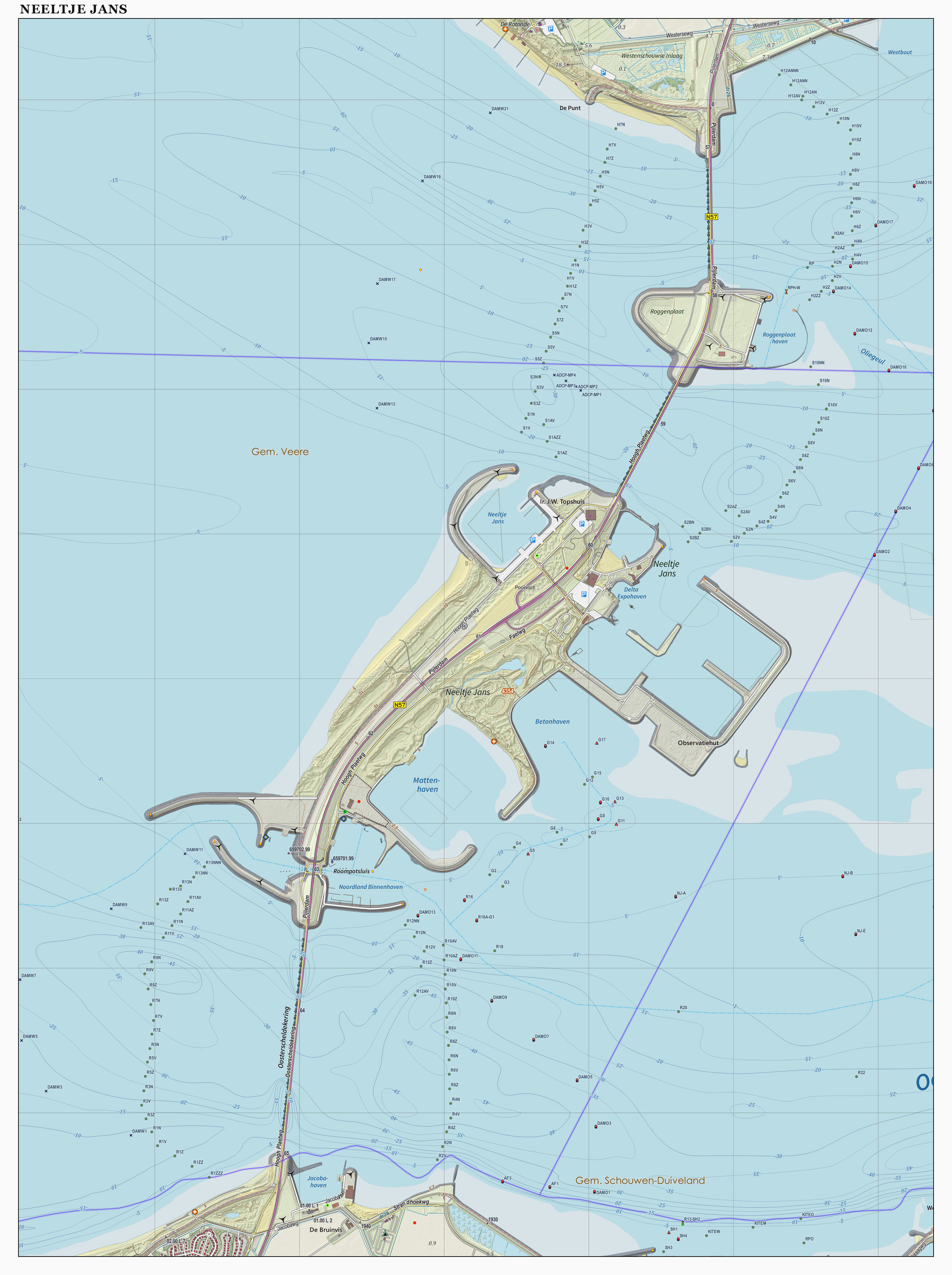Oosterscheldekering on:
[Wikipedia]
[Google]
[Amazon]

 The Oosterscheldekering ( English: Eastern Scheldt storm surge barrier), between the islands
The Oosterscheldekering ( English: Eastern Scheldt storm surge barrier), between the islands

 The Oosterscheldekering was the most difficult to build and most expensive part of the Delta works. Work on the dam took more than a decade. It was constructed by a consortium of contractors comprising Ballast Nedam, Boskalis Westminster, Baggermaatschappij Breejenhout, Hollandse Aanneming Maatschappij, Hollandse Beton Maatschappij,
The Oosterscheldekering was the most difficult to build and most expensive part of the Delta works. Work on the dam took more than a decade. It was constructed by a consortium of contractors comprising Ballast Nedam, Boskalis Westminster, Baggermaatschappij Breejenhout, Hollandse Aanneming Maatschappij, Hollandse Beton Maatschappij,
 Four ships were custom designed and built for this project:
* ''Mytilus'', a ship equipped with various ground working tools, such as needles to make the seabed denser and more stable.
* ''Cardium'', a ship to transport and lay a special
Four ships were custom designed and built for this project:
* ''Mytilus'', a ship equipped with various ground working tools, such as needles to make the seabed denser and more stable.
* ''Cardium'', a ship to transport and lay a special
Satellite view from Google Maps
DeltaWorks.org
– DeltaWorks.Org about Oosterscheldekering. Includes text, photos, video and virtual tour. {{Authority control Buildings and structures in Schouwen-Duiveland Dams completed in 1986 Dams in the Netherlands Delta Works Flood barriers Noord-Beveland Tourist attractions in Zeeland

 The Oosterscheldekering ( English: Eastern Scheldt storm surge barrier), between the islands
The Oosterscheldekering ( English: Eastern Scheldt storm surge barrier), between the islands Schouwen-Duiveland
Schouwen-Duiveland () is a municipality and an island in the southwestern Netherlands province of Zeeland. The municipality has 33,737 inhabitants (1 January 2016) and covers an area of (of which is water).
The northside of the island has two fi ...
and Noord-Beveland
Noord-Beveland (; "North Beveland") is a municipality and region in the southwestern Netherlands and a former island, now part of the Walcheren- Zuid-Beveland-Noord-Beveland peninsula.
Noord-Beveland is enclosed by the Oosterschelde estuary to ...
, is the largest of the Delta Works
The Delta Works ( nl, Deltawerken) is a series of construction projects in the southwest of the Netherlands to protect a large area of land around the Rhine–Meuse–Scheldt delta from the sea. Constructed between 1954 and 1997, the works con ...
, a series of dams and storm surge barriers, designed to protect the Netherlands
)
, anthem = ( en, "William of Nassau")
, image_map =
, map_caption =
, subdivision_type = Sovereign state
, subdivision_name = Kingdom of the Netherlands
, established_title = Before independence
, established_date = Spanish Netherl ...
from flooding from the North Sea. The construction of the Delta Works was a response to the widespread damage and loss of life in the North Sea flood of 1953.
Surge barrier
The longest dam in theDelta Works
The Delta Works ( nl, Deltawerken) is a series of construction projects in the southwest of the Netherlands to protect a large area of land around the Rhine–Meuse–Scheldt delta from the sea. Constructed between 1954 and 1997, the works con ...
, the nine-kilometre-long Oosterscheldekering (''kering'' meaning barrier) was initially designed, and partly built, as a closed dam, but after public protests, huge sluice-gate-type doors were installed in the remaining four kilometres. These doors are normally open, but can be closed under adverse weather conditions. In this way, the saltwater marine life behind the dam is preserved and fishing can continue, while the land behind the dam is safe from the water.
On 4 October 1986, Queen Beatrix
Beatrix (Beatrix Wilhelmina Armgard, ; born 31 January 1938) is a member of the Dutch royal house who reigned as Queen of the Netherlands from 1980 until her abdication in 2013.
Beatrix is the eldest daughter of Queen Juliana and her husban ...
officially opened the dam for use by saying the well-known words: "''De stormvloedkering is gesloten. De Deltawerken zijn voltooid. Zeeland is veilig.''" (The flood barrier is closed. The Delta Works are completed. Zeeland
, nl, Ik worstel en kom boven("I struggle and emerge")
, anthem = "Zeeuws volkslied"("Zeelandic Anthem")
, image_map = Zeeland in the Netherlands.svg
, map_alt =
, m ...
is safe.)
At the artificial island Neeltje-Jans
Neeltje Jans () is an artificial island in the Netherlands in the province of Zeeland, halfway between Noord-Beveland and Schouwen-Duiveland in the Oosterschelde. It was constructed to facilitate the construction of the Oosterscheldedam.
After th ...
, at one end of the barrier, a plaque is installed with the words: "''Hier gaan over het tij, de maan, de wind en wij''" ("Here the tide is ruled by the moon, the wind and us").
Construction

 The Oosterscheldekering was the most difficult to build and most expensive part of the Delta works. Work on the dam took more than a decade. It was constructed by a consortium of contractors comprising Ballast Nedam, Boskalis Westminster, Baggermaatschappij Breejenhout, Hollandse Aanneming Maatschappij, Hollandse Beton Maatschappij,
The Oosterscheldekering was the most difficult to build and most expensive part of the Delta works. Work on the dam took more than a decade. It was constructed by a consortium of contractors comprising Ballast Nedam, Boskalis Westminster, Baggermaatschappij Breejenhout, Hollandse Aanneming Maatschappij, Hollandse Beton Maatschappij, Van Oord
Royal Van Oord is a Dutch maritime contracting company that specializes in dredging, land reclamation and constructing man made islands. Royal Van Oord has undertaken many projects throughout the world, including land reclamation, dredging and beac ...
-Utrecht, Stevin Baggeren, Stevin Beton en Waterbouw, Adriaan Volker Baggermaatschappij, Adriaan Volker Beton en Waterbouw and Aannemerscombinatie Zinkwerken. Construction started in April 1976 and was completed in June 1986. The road over the dam was ready for use in November 1987.
The road was opened by the former queen, Princess Juliana on 5 November 1987, exactly 457 years after the St Felix Day's flood of 1530, which had washed away a large chunk of Zeeland
, nl, Ik worstel en kom boven("I struggle and emerge")
, anthem = "Zeeuws volkslied"("Zeelandic Anthem")
, image_map = Zeeland in the Netherlands.svg
, map_alt =
, m ...
, upstream of the new barrier's position.
To facilitate the building, an artificial island, Neeltje-Jans
Neeltje Jans () is an artificial island in the Netherlands in the province of Zeeland, halfway between Noord-Beveland and Schouwen-Duiveland in the Oosterschelde. It was constructed to facilitate the construction of the Oosterscheldedam.
After th ...
, was created in the middle of the estuary. When the construction was finished, the island was rebuilt to be used as education centre for visitors and as a base for maintenance works.
The dam is based on 65 concrete pillars with 62 steel doors, each 42 metres wide. The parts were constructed in a dry dock. The area was flooded and a small fleet of special construction ships lifted the pillars and placed them in their final positions. Each pillar is between 35 and 38.75 metres high and weighs 18000 tonne
The tonne ( or ; symbol: t) is a unit of mass equal to 1000 kilograms. It is a non-SI unit accepted for use with SI. It is also referred to as a metric ton to distinguish it from the non-metric units of the short ton ( United State ...
s. The dam is designed to last more than 200 years.
The Oosterscheldekering is sometimes referred to as the eighth Wonder of the World. It has been declared one of the modern Seven Wonders of the World
Various lists of the Wonders of the World have been compiled from antiquity to the present day, in order to catalogue the world's most spectacular natural features and human-built structures.
The Seven Wonders of the Ancient World is the o ...
by the American Society of Civil Engineers
American(s) may refer to:
* American, something of, from, or related to the United States of America, commonly known as the "United States" or "America"
** Americans, citizens and nationals of the United States of America
** American ancestry, pe ...
.
Construction fleet
foil
Foil may refer to:
Materials
* Foil (metal), a quite thin sheet of metal, usually manufactured with a rolling mill machine
* Metal leaf, a very thin sheet of decorative metal
* Aluminium foil, a type of wrapping for food
* Tin foil, metal foil ...
carpet on the seabed for the pillars to rest on.
* ''Ostrea'', a ship capable of lifting a concrete
Concrete is a composite material composed of fine and coarse aggregate bonded together with a fluid cement (cement paste) that hardens (cures) over time. Concrete is the second-most-used substance in the world after water, and is the most wid ...
pillar
A column or pillar in architecture and structural engineering is a structural element that transmits, through compression, the weight of the structure above to other structural elements below. In other words, a column is a compression member. ...
from the dry dock and placing it accurately on a special foil on the seabed. The ship is 85 metres long and has a portal 50 metres high. The ship can only lift 10,000 tonnes, but as a large part of the pillar is underwater, it is not necessary for the ship to be able to lift the full 18,000 tonnes. This ship is considered the flagship of the construction fleet, mainly because of its larger size and power in comparison to the other ships.
* ''Macoma'', a ship that works closely with the Ostrea, cleaning the foil assisting in placing the pillars accurately in their final position.
The ships are named after various types of shellfish.
Operation
The dam is manually operated but if human control fails, an electronic security system acts as a backup. A Dutch law regulates the conditions under which the dam is allowed to close. The water levels must be at least three meters above regular sea level before the doors can be completely shut. Each sluice gate is closed once a month for testing. Emergency procedures are tested on pre-scheduled dates. Once the test is passed, the shutters are quickly opened again to create a minimum amount of effect on tidal movements and the local marine ecosystem. It takes approximately one hour to close a door. The cost of operation is €17 million per year. The full dam has been closed twenty-eight times since 1986, due to water levels exceeding or being predicted to exceed the three metres. The last time was on January 31 2022, because of Storm Corrie.Further reading
*External links
*Satellite view from Google Maps
DeltaWorks.org
– DeltaWorks.Org about Oosterscheldekering. Includes text, photos, video and virtual tour. {{Authority control Buildings and structures in Schouwen-Duiveland Dams completed in 1986 Dams in the Netherlands Delta Works Flood barriers Noord-Beveland Tourist attractions in Zeeland